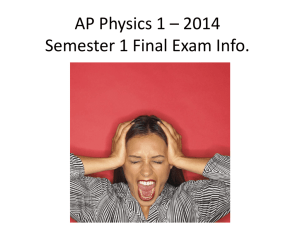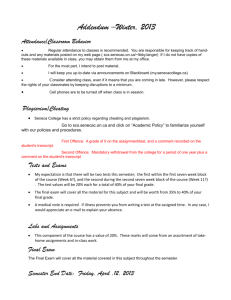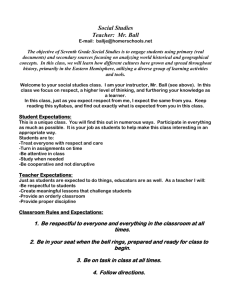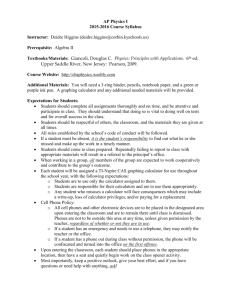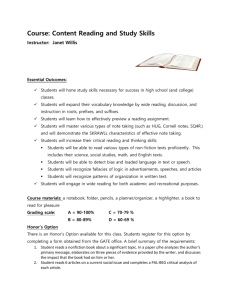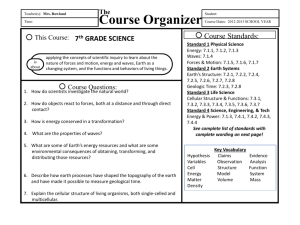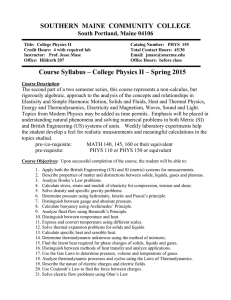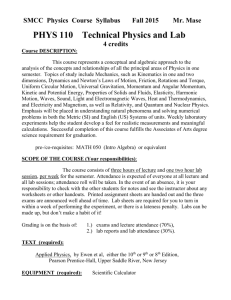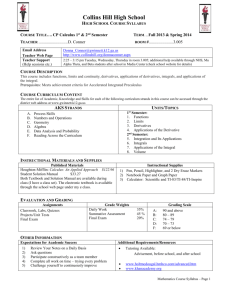AP Physics B * Syllabus 2007 * 2008 - Mrs. Ryan`s Site
advertisement
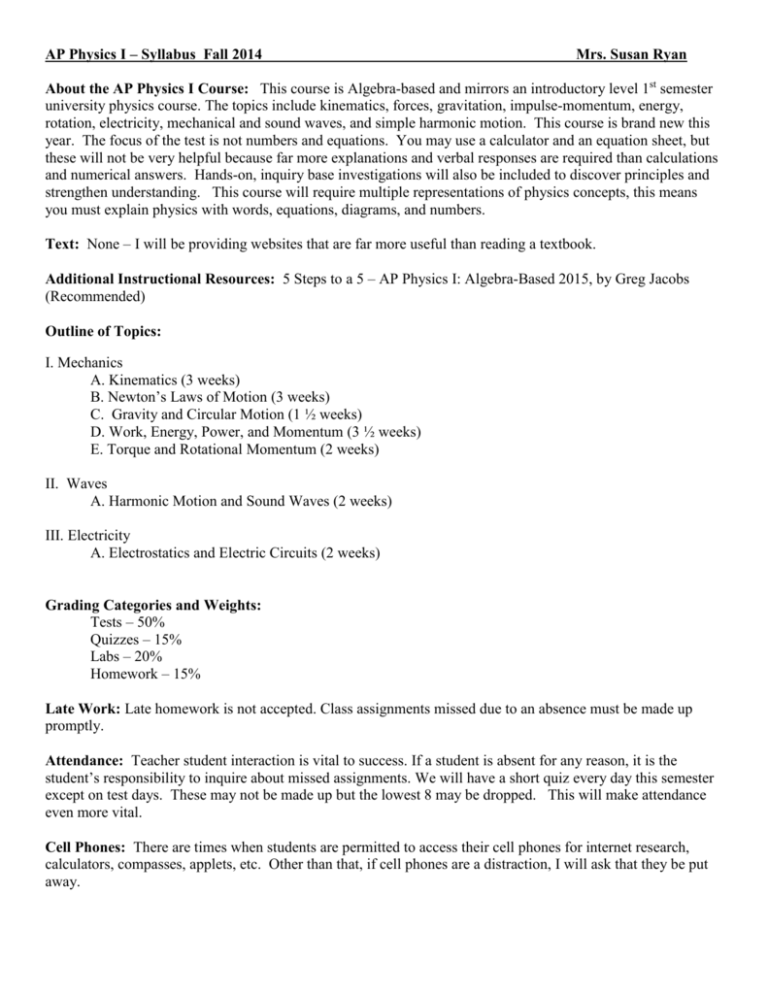
AP Physics I – Syllabus Fall 2014 Mrs. Susan Ryan About the AP Physics I Course: This course is Algebra-based and mirrors an introductory level 1st semester university physics course. The topics include kinematics, forces, gravitation, impulse-momentum, energy, rotation, electricity, mechanical and sound waves, and simple harmonic motion. This course is brand new this year. The focus of the test is not numbers and equations. You may use a calculator and an equation sheet, but these will not be very helpful because far more explanations and verbal responses are required than calculations and numerical answers. Hands-on, inquiry base investigations will also be included to discover principles and strengthen understanding. This course will require multiple representations of physics concepts, this means you must explain physics with words, equations, diagrams, and numbers. Text: None – I will be providing websites that are far more useful than reading a textbook. Additional Instructional Resources: 5 Steps to a 5 – AP Physics I: Algebra-Based 2015, by Greg Jacobs (Recommended) Outline of Topics: I. Mechanics A. Kinematics (3 weeks) B. Newton’s Laws of Motion (3 weeks) C. Gravity and Circular Motion (1 ½ weeks) D. Work, Energy, Power, and Momentum (3 ½ weeks) E. Torque and Rotational Momentum (2 weeks) II. Waves A. Harmonic Motion and Sound Waves (2 weeks) III. Electricity A. Electrostatics and Electric Circuits (2 weeks) Grading Categories and Weights: Tests – 50% Quizzes – 15% Labs – 20% Homework – 15% Late Work: Late homework is not accepted. Class assignments missed due to an absence must be made up promptly. Attendance: Teacher student interaction is vital to success. If a student is absent for any reason, it is the student’s responsibility to inquire about missed assignments. We will have a short quiz every day this semester except on test days. These may not be made up but the lowest 8 may be dropped. This will make attendance even more vital. Cell Phones: There are times when students are permitted to access their cell phones for internet research, calculators, compasses, applets, etc. Other than that, if cell phones are a distraction, I will ask that they be put away. Cheating and Plagiarism: Cheating or plagiarism of any kind is not tolerated. A lot of collaboration will take place in class and at home but I expect each person in the group to be contributing, not just copying someone else’s work. The student that cheats or plagiarizes will receive a zero for the assignment or test. The AP exam: The AP exam will be a 3 hour exam. There are 50 multiple choice questions that you have 1 ½ hours to complete (about 2 minutes per question) and constitute 50% of your grade. Most of these are traditional multiple choice with 4 answer choices, but 5 questions will be “multiple correct” questions where you must mark 2 correct answers in order to receive credit. There is no penalty for guessing. There are 5 free response questions that have multiple parts to them and will require justification for each answer. You also have 1 ½ hrs for this section and it constitutes 50% of the grade. There will be 2 long 12-point questions and 3 shorter 7point questions so you will also have about 2 minutes per point on this section. One of the long free response questions will be posed in a laboratory setting, asking for descriptions of experiments and analyses of data. You will be able to use a calculator and an equation sheet but they will not be a huge help to you. By the time you take the test, you will understand relationships well enough to not need the equation sheet and there will only be about 3 questions where a calculator will be needed. Historically, it has taken about 60 to 65 percent to earn a 5 and about 50 percent to earn a 4. I will model the tests during the semester after the AP test so you should be well prepared when it comes. What I Really Think: AP Physics I is a hard college level course in terms of pace and rigor. Many students with an excellent academic history will initially struggle in the course as they adjust and learn to think critically and develop problem solving strategies for complex problems. However, this task is doable. Please be patient and understanding with your student, encourage them to form small study groups and to come see me early in the mornings for extra help (I am available starting at 7:30 each morning). With consistent effort, students will succeed and take many valuable academic skills away with them. I will tell the students on day one that this course is best tackled with some help. Students need to raise their hands in class, ask questions, discuss problems with each other at lunch, etc. One analogy: as the AP coach, I will call the plays for a successful offense. The students have to practice the plays and then execute on game day. And if their work and effort has been sufficient, they will win. In closing, I LOVE teaching and I LOVE physics and I want your students to enjoy this taking this class as much as I enjoy teaching it. Please sign below to acknowledge that you have read and understood the above letter. And also provide emails and phone numbers where you can be contacted. ____________________________________ Student printed name _______________________________ Student signature Student email __________________________________________ ____________________________________ Parent printed name ________________________________ Parent signature Parent email ____________________________________________ Parent phone number _____________________________________
